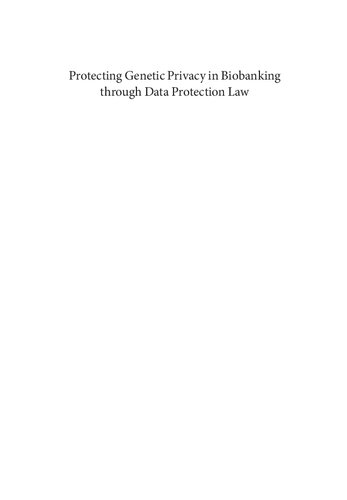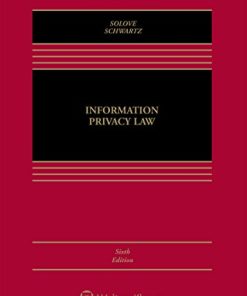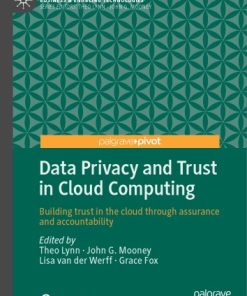(Ebook PDF) Protecting Genetic Privacy in Biobanking through Data Protection Law 1st edition by Dara Hallinan ISBN 9780192650399 0192650394 full chapters
$50.00 Original price was: $50.00.$25.00Current price is: $25.00.
(Ebook PDF) Protecting Genetic Privacy in Biobanking through Data Protection Law 1st edition by Dara Hallinan-Ebook PDF Instant Download/Delivery:9780192650399, 0192650394
Instant download Full Chapter of Protecting Genetic Privacy in Biobanking through Data Protection Law 1st edition after payment

Product details:
ISBN 10:0192650394
ISBN 13:9780192650399
Author: Dara Hallinan
Table of Contents:
- 1. Introduction
- 2. Genetic Data, Genome Understanding, and Socially Relevant Information
- A. Introduction
- B. Types of Genetic Data
- C. Types of Socially Significant Information Revealed via Genetic Analysis
- D. The Range of Genetic Analyses Potentially Applicable to Genetic Data
- E. The Accuracy of Information Produced via Genetic Analysis
- F. The Range of Parties Implicated by Genetic Analyses
- G. Conclusion
- 3. The Context and State of the Art in European Biobanking
- A. Introduction
- B. The Human Genome Project: Where It All Began
- C. Organisational Legacies of the Human Genome Project
- D. Methodological Legacies of the Human Genome Project
- E. The Promises of Genomic Research
- F. The Unfulfillable Promises of Genomic Research?
- G. Defining Biobanks: A Loose Definition for a Heterogeneous Class
- H. Variations in European Biobanking: Scientific Approach
- I. Variations in European Biobanking: Organisational Structure
- J. Variations in European Biobanking: Substance Ownership and Intellectual Property
- K. Variations in European Biobanking: Approach to Research Subjects
- L. Future Trends in European Biobanking
- M. Conclusion
- 4. Genetic Privacy and Other Interests in Biobanking: Conflict and Confluence
- A. Introduction
- B. Privacy: As a Condition and as a Right
- C. Genetic Privacy Rights: A Subset of Privacy Rights
- D. Mapping Genetic Privacy Rights Engaged by Biobanking: The Research Subject’s Genetic Privacy Rights on the Transactional Axis
- E. Mapping Genetic Privacy Rights Engaged by Biobanking: Genetic Relatives’ and Genetic Groups’ Genetic Privacy Rights on the Relational Axis
- F. Genetic Classes and Genetic Categories: Two Different Kinds of Genetic Groups
- G. Mapping Other Interests Engaged by Biobanking: Interests Tied Up with the Conduct and Outcome of Biobank Research
- H. Mapping Other Interests Engaged by Biobanking: Third-Party Non-Research Interests in Accessing Biobanking Substances
- I. Mapping the Relationships between Genetic Privacy Rights and Other Interests: Conflicts
- J. Mapping the Relationships between Genetic Privacy Rights and Other Interests: Confluences
- K. Conclusion
- 5. The Protection of Genetic Privacy in Biobanking at International Level: Establishing a Baseline Standard for Genetic Privacy Protection in Biobanking
- A. Introduction
- B. The Structure of the International Framework
- C. Common International Principles Regarding Research Subjects’ Genetic Privacy on the Transactional Axis
- D. Common International Principles Regarding Genetic Relatives’ and Groups’ Genetic Privacy on the Relational Axis
- E. Emerging International Principles Regarding Research Subjects’ Genetic Privacy on the Transactional Axis
- F. Emerging International Principles Regarding Genetic Relatives’ and Groups’ Genetic Privacy on the Relational Axis
- G. Problems of Structure: The International Framework Is Not Hard Law
- H. Problems Along the Transactional Axis: The International Framework Does Not Provide Protection for the Full Range of Research Subjects’ Genetic Privacy Rights
- I. Problems Along the Relational Axis: The International Framework Does Not Provide Protection for the Full Range of Genetic Privacy Rights Holders
- J. Problems with the Standard of Protection: The International Framework Provides Incomprehensive Protection
- K. Conclusion
- 6. Do we Need Data Protection at All? Evaluating Protection for Genetic Privacy in Biobanking in Europe Excluding Data Protection
- A. Introduction
- B. Selection of European Legal Systems to Analyse
- C. EU Law Excluding Data Protection
- D. Estonian Law Excluding Data Protection
- E. German Law Excluding Data Protection
- F. UK Law Excluding Data Protection
- G. Problems of Structure: No System—Excluding Data Protection— Is Optimally Structured to Protect Genetic Privacy in Biobanking
- H. Problems with the Protection of Research Subjects’ Genetic Privacy: Excluding Data Protection, Only Estonia Protects the Full Range of Genetic Privacy Rights
- I. Problems with the Protection of Genetic Relatives’ and Genetic Groups’ Genetic Privacy: No System—Excluding Data Protection—Protects Genetic Relatives or Groups
- J. Problems with the Adequacy of Protection: No System—Excluding Data Protection—Provides Comprehensive Protection
- K. Problems of Harmony: Systems—Excluding Data Protection— Are Neither Harmonised, Nor Necessarily Compatible
- L. Looking to Data Protection and the GDPR
- M. Conclusion
- 7. Testing the GDPR in Relation to Biobanking: When Does the GDPR Apply to Biobanking?
- A. Introduction
- B. The GDPR’s General Applicability Principles: Article 2 and Biobanking
- C. Personal Data and Its Constituent Criteria
- D. Which Biobanking Substances Could Potentially Be Personal Data?
- E. Biological Samples as Personal Data? Practical Parallels Between Biological Samples and Sequenced Genomic Data
- F. Biological Samples as Personal Data? Biological Samples Can Be Considered in Terms of Information
- G. Biological Samples as Personal Data? Biological Samples Can Be Considered as Information as the Term Is Used in the GDPR
- H. Which Biobanking Links Qualify as Identified or Identifiable?
- I. Conclusion
- 8. Testing the GDPR in Relation to Biobanking: How Does the GDPR classify the Biobanking Process?
- A. Introduction
- B. Two Classifications Systems: The Actor Classification System and the Personal Data Classification System
- C. The Applicability of the Actor Classification System to Biobanking
- D. The Applicability of the Personal Data Classification System to Biobanking
- E. Conclusion
- 9. Testing the GDPR in Relation to Biobanking: How Do the GDPR’s Substantive Provisions Apply to Biobanking?
- A. Introduction
- B. Biobanking and Oversight under the GDPR
- C. Biobanking and Legitimate Processing under the GDPR
- D. Biobanking and Data Subject Rights under the GDPR
- E. Biobanking and Data Controller Obligations under the GDPR
- F. Biobanking and Transfers to Third Countries under the GDPR
- G. Biobanking and Sanctions under the GDPR
- H. Biobanking and Derogations under the GDPR
- I. Conclusion
- 10. A Critical Analysis of the Efficacy of the GDPR as a Framework for the Protection of Genetic Privacy in Biobanking
- A. Introduction
- B. A Framework for the Critical Analysis of the GDPR
- C. Problems Concerning the Structure of the GDPR
- D. Problems Concerning the Protection of Research Subjects’ Genetic Privacy Rights on the Transactional Axis
- E. Problems Concerning the Protection of Genetic Relatives’ and Genetic Groups’ Genetic Privacy Rights on the Relational Axis
- F. Problems Concerning the Substantive Protection Offered by the GDPR
- G. Problems Concerning the Technical Applicability of the GDPR’s Provisions to Biobanking
- H. Problems Concerning the Disproportionate Impact of the GDPR on Research
- I. Problems Concerning the Practical Applicability of the GDPR to Biobanking
- J. Problems Concerning the Degree to Which the GDPR Harmonises Protection
- K. Conclusion
- 11. Conclusion
People also search:
genetic privacy laws
biotechnology privacy issues
explain what privacy issues biotechnology raises
protecting genetic data
protecting genetic information
Tags:
Dara HallinanProtecting Genetic Privacy,Biobanking,Data Protection Law
You may also like…
Jurisprudence & Law Computers - Computer Business & Culture
Computers - Computer Certification & Training
CDPSE Certified Data Privacy Solutions Engineer All-in-One Exam Guide 1st edition Peter H. Gregory
Business & Economics - Responsibility and Business Ethics
Business & Economics
Data Privacy And GDPR Handbook 1st Edition by Sanjay Sharma 1119594197 9781119594192
Computers - Computer Certification & Training
CDPSE Certified Data Privacy Solutions Engineer All-in-One Exam Guide 1st Edition Peter H. Gregory
Computers - Security
Business & Economics











